

| Rearing Cryptocephalus coryli in captivity | ||
| .... | ||
| In late April and
early May 2011, we took three female and two male Cryptocephalus
coryli into captivity for three days, in order to
obtain eggs and rear the larvae in captivity. The aim was
to obtain photographs of the early stages of the
life-cycle and to rear the larvae to maturity. A few days after obtaining a number of eggs and the adults returned to the site of capture, we were extremely fortunate to find two half-grown larvae under leaf litter at Sherwood Forest Country Park. This piece of good fortune has already helped part fill the sequence of life-cycle photographs we are after, a year earlier than we had anticipated it would take. This page will be updated on a regular basis with additional photographs and notes, as and when they become available. Last updated - 24/05/11. |
||
| .... | ||
| Cryptocephalus coryli female covering the recently laid egg in faeces to produce the characteristic 'pot'. Photographed at Sherwood Forest CP in May 2009. | ||
| .... | ||
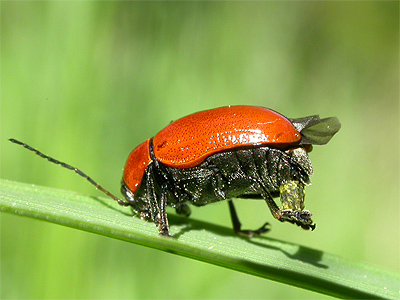 |
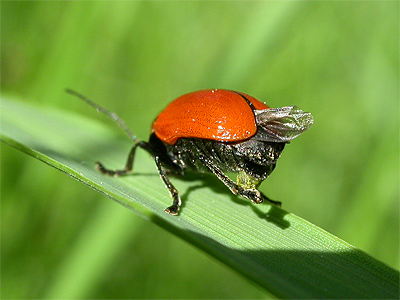 |
|
| .... | ||
| Cryptocephalus coryli ovae produced by captive female, laid and photographed on 05/05/11. One ova is only partially covered with dung leaving the ova exposed, which only rarely occurs. The other ova is fully covered with dung to create the characteristic pot, from which the beetle derives its name. Even when laying and covering the pot with faeces, the female often produces an obvious flat end to the pot. | ||
| .... | ||
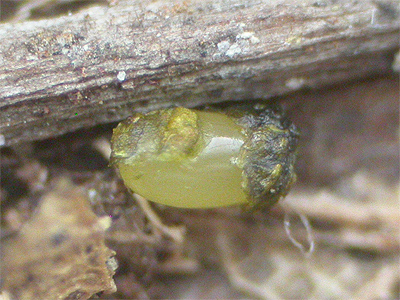 |
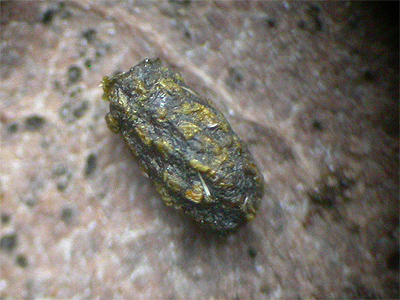 |
|
| .... | ||
| Hatching Cryptocephalus coryli larva, photographed on 24/05/11. On hatching, the larva breaks through the end of the pot and ejects the remains of the egg case as shown in these photographs. In the left photograph, the larva is turning round and actually has its back to the pot entrance, which is gradually adjusted till it fits the head of the larva perfectly. We believe it likely that the larva also does some alterations to the inside of the pot at this early stage, to make it the correct shape. | ||
| .... | ||
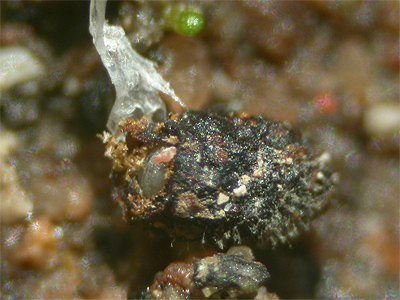 |
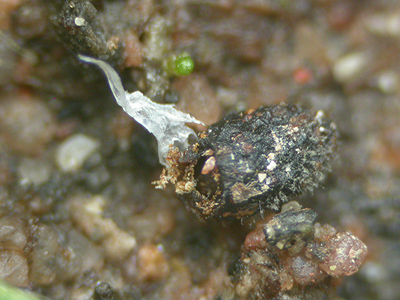 |
|
| .... | ||
| Newly hatched Cryptocephalus coryli larva, photographed on 23/05/11. Hatching of the first larvae occurred from 22/05/11, approximately 17 days (kept at room temperature) after ova were laid. The estimated length of the larva at this stage is about 0.75mm maximum. In these photographs, the pot entrance has already been adjusted to the correct size. | ||
| .... | ||
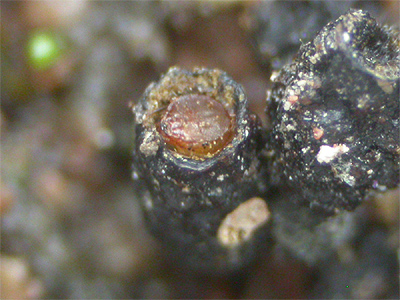 |
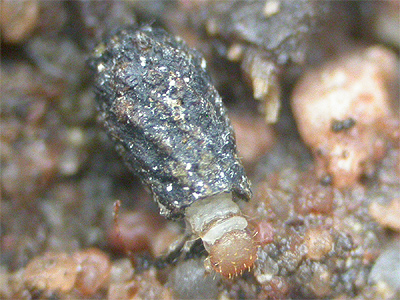 |
|
| .... | ||
| Larval development and growth is quite noticeable, even at just four days old. Photographed on 27/05/11, the next two photographs show how the larvae develop the collars on the pots with fresh faeces. | ||
| .... | ||
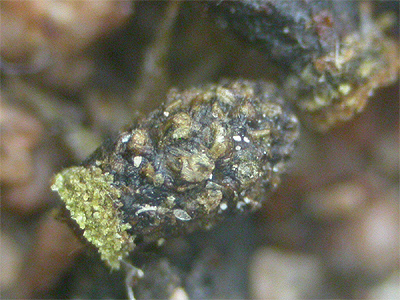 |
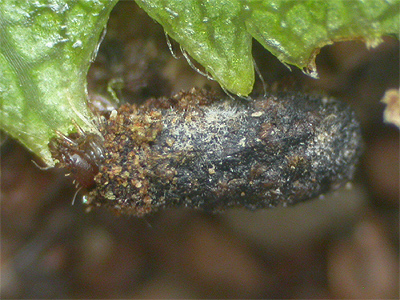 |
|
| .... | ||
| Growth was relatively quick in captivity, with the pots measured 6mm in length by July 8th. The accopanying photographs show some recent extending to the front of the pot enlargement, viewable as the thin green strip along the underside. In the wild, growth is considerably slower. | ||
| .... | ||
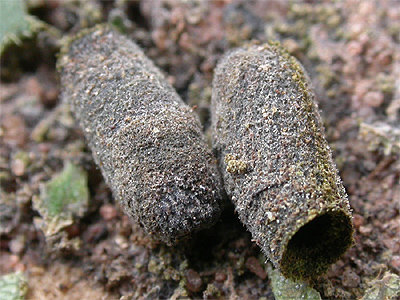 |
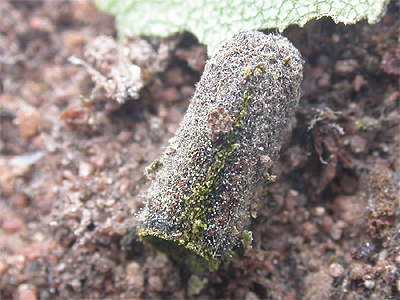 |
|
| .... | ||
| Cryptocephalus coryli larva and pot measuring 8mm. This pot was originally found under leaf litter and photographed at Sherwood Forest CP on 16/05/11. A further pot of the same length, was also found under leaf litter on 18/05/2011 and taken into captivity for rearing and features in some of the following photographs. In captivity, both these larvae were initially kept on a substrate of broken down leaf litter and had a tendancy to half bury themselves (head down) into it. We later moved them into a fresh container with damp sand used as a substrate and fed on a diet of fresh Birch leaves. | ||
| .... | ||
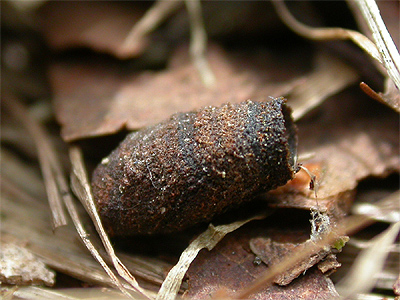 |
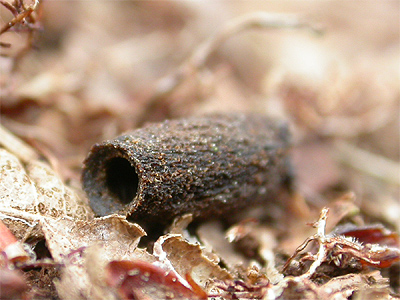 |
|
| .... | ||
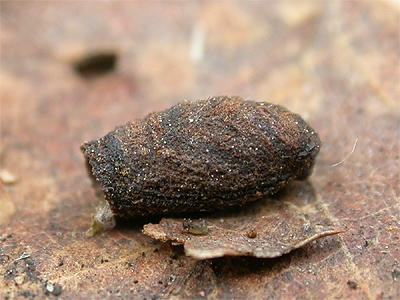 |
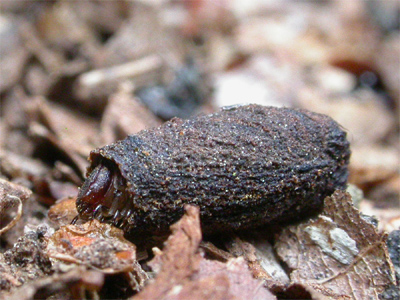 |
|
| .... | ||
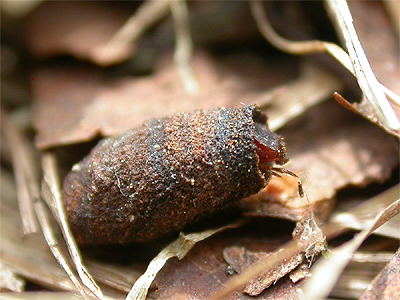 |
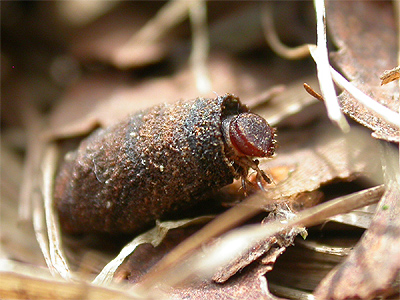 |
|
| .... | ||
| The following short series of photographs show the larval pot of Cryptocepahlus coryli in close up. The pot is made up of bands of different colours of faeces, presumably due to the food eaten. | ||
| .... | ||
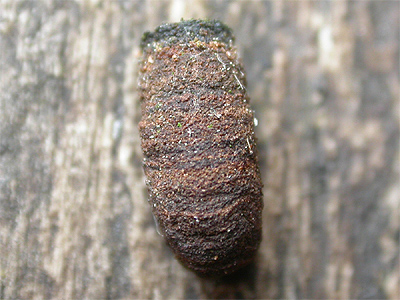 |
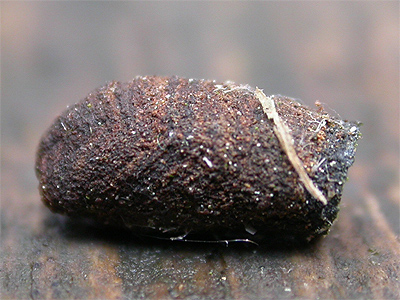 |
|
| .... | ||
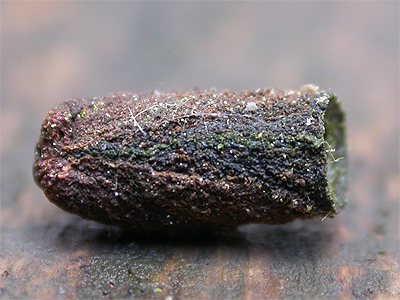 |
The photograph on the
left, shows how the pot is enlarged by the larva as it
continues to grow. A slit is cut lengthways down the
underside of the pot and fresh faeces inserted to fill
the gap. It is just possible to make out a thin strip of
green faeces, where the larva has recently enlarged the
pot. The darker area of the 'V' shape is caused by a
succession of enlargements. The pot when viewed from the front, shows how the opening is adjusted after the pot has been enlarged, to ensure that it precisely the width of the larva's head. Within a few days of both these pots being enlarged, both larvae sealed up their respective pot entrance. They remained like this for a further couple of days, presumably whilst a moult was completed, before opened up the entrance and beginning to feed again. |
|
| .... | ||
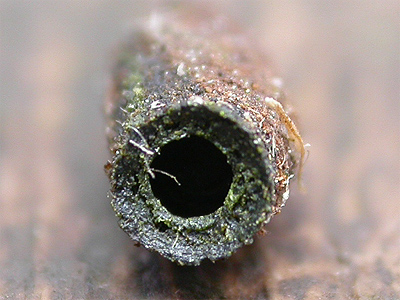 |
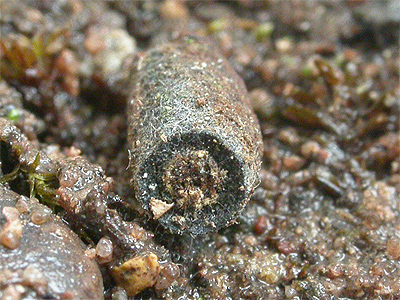 |
|
| .... | ||
| One of the pots originally collected from the wild on 16/05/11 and 18/05/11 grew at a tremendous rate in captivity. Photographed again a fortnight later on 31/05/11, this pot was about a third larger than the other and shows a change in shape and two distinctly different textures to the surface. The lower left photograph shows the back of the larva as it turns in the pot. | ||
| .... | ||
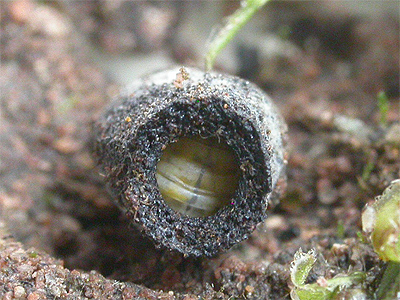 |
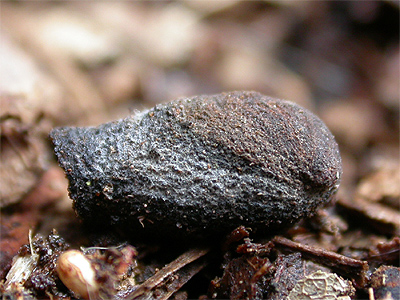 |
|
| .... | ||
| The almost fully mature larva and pot, photographed on 06/06/11. | ||
| .... | ||
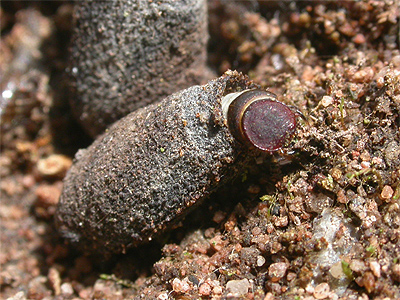 |
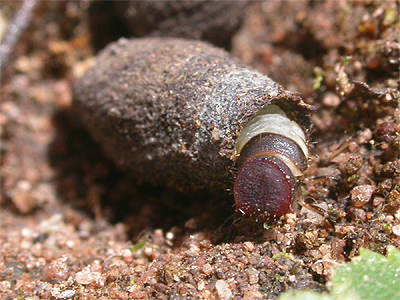 |
|
| .... | ||
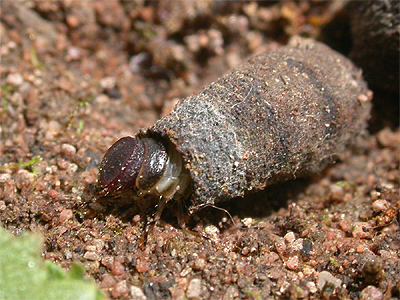 |
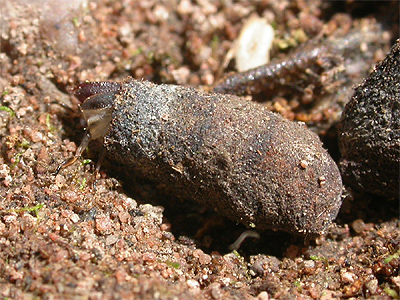 |
|
| .... | ||
| Larva and pot, photographed on 11/07/11. Despite the pot appearing to be extremely cumbersome, the larvae are still able to walk around with the pot completely off the ground, in the same way as much younger larvae do. This was actually the first time we had recorded this, whilst we were taking the following four photographs. There seems little difference to the pot in these photographs, compared to the ones above. Apart from the pot being only slightly larger, the collar has become more extended and defined. | ||
| .... | ||
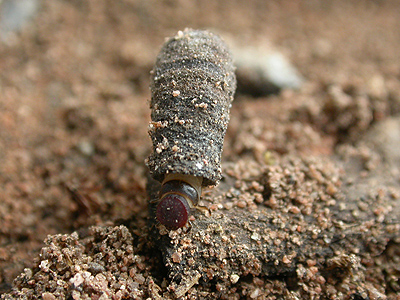 |
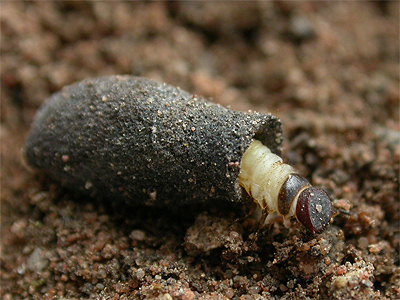 |
|
| .... | ||
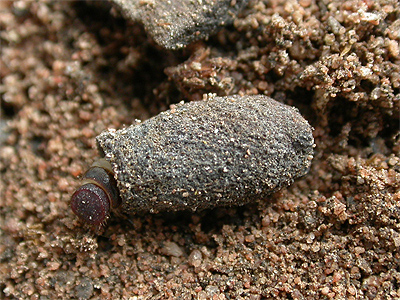 |
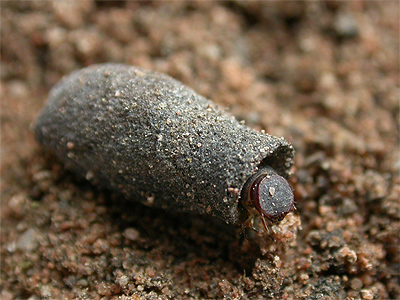 |
|
| .... | ||
| By late July,
the two larvae collected from the wild measured 8.5mm and
10mm in length, but stopped eating at this time and
remained dormant until the middle of September at least.
However, the larvae reared from captive females continued
to develop at an astonishing rate, so that the majority
were now larger than the two found in the wild. Given
warm conditions, it is very likely that C.
coryli larvae are capable of maturing within 12
months. The following group of four photographs all show larvae and their pots hatched in captivity and photographed on 17/09/11. The bottom right photograph shows the sealed off pot which measures 15mm and two other smaller pots all bred in 2011. Whilst all should reach the adults stage in Spring 2012, there is quite a variation in the rate of growth between larvae. |
||
| .... | ||
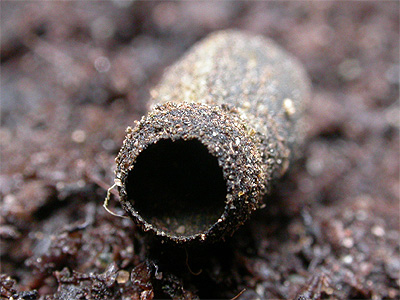 |
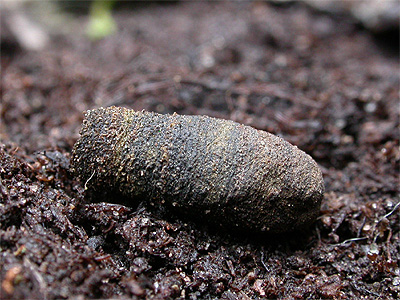 |
|
| .... | ||
| It seems that some larvae are full grown and have almost sealed off the open end of the pot, with a strange extension of the pot's outer rim, which almost encloses the open end. The photograph above left shows the part construction of the extension over the open end of the pot, which is virtually complete in the photograph shown below left. | ||
| .... | ||
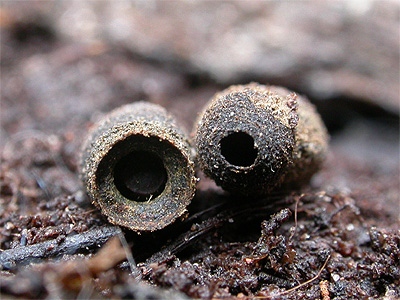 |
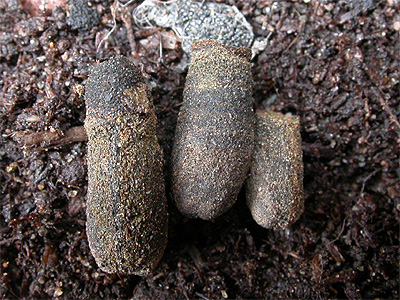 |
|
| .... | ||
| Adult female Cryptocephalus coryli emerging from its pot on May 13th 2012. Emergence is a swift process and the adults are immediately active. | ||
| .... | ||
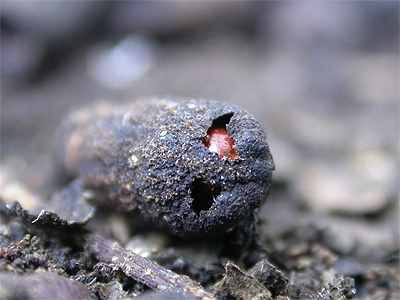 |
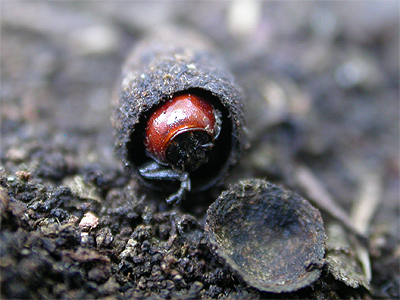 |
|